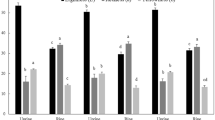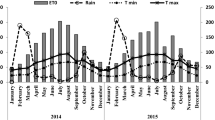Abstract
Pepper (Capsicum annuum L.) fruits are highly appreciated by producers and consumers for their economical and nutritional value. Four different cultivars of coloured peppers in immature and mature stages were harvested throughout the spring and examined for their content of phenolic compounds, ascorbic acid and total antioxidant capacity (TAA) as well as for lipid peroxidation and carbonyl proteins as index of oxidative stress. Ripening and harvest period influenced the antioxidants and the development of oxidative processes in the cultivars differently: lipid peroxidation increased in mature peppers except in one cultivar (Y1075), while no changes in protein oxidation or in TAA were produced, except in Y1075 in which both parameters increased. Each cultivar presented differences in antioxidant compounds depending on the harvest period, but we could recommend May as the optimal if all cultivars have to be harvested at the same time, when levels of ascorbate, phenols and TAA were not decreased, fresh weight and proteins were elevated, and levels of oxidation were not as high as in June (except for Y1075). A previous study of the response of each cultivar to different environmental conditions results essential to establish a good program of selection of cultivars with high quality and productivity.



Similar content being viewed by others
Abbreviations
- ASC:
-
L-ascorbic acid
- CO-protein:
-
Carbonylated-proteins
- DHA:
-
Dehydroascorbate
- ROS:
-
Reactive oxygen species
- TAA:
-
Total antioxidant activity
- TBARS:
-
Thiobarbituric acid reactive substances
References
Howard LR, Talcott SL, Brenes CH, Villalon B (2000) Changes in phytochemical and antioxidant activity of selected pepper cultivar (Capsicum annum) as influenced by maturity. J Agric Food Chem 48:1713–1720
Palma JM, Corpas FJ, del Río LA (2009) Plant vitamin antioxidants and their influence on the human diet. In: Papareschi A, Eppolito H (eds), Vegetable Consumption and Health. New York: Nova Science Publishers, pp 127–138
Sies H (1991) Oxidative stress-from basic research to clinical-application. Am J Med 91:S31–S38
Seddon JM, Ajani UA, Sperduto RD, Hiller R, Blair N, Burton TC, Farber MD, Gragoudas ES, Haller J, Miller DT, Yannuzzi LA, Willet W (1994) Dietary carotenoids, vitamins A, C, and E, and advanced age-related macular degeneration. J Am Med Assoc 272:1413–1420
Knekt P, Jarvinen R, Reunanen A, Maatela J (1996) Flavonoid intake and coronary mortality in Finland: A cohort study. Br Med J 312:478–481
Bouvier F, Backhaus RA, Camara B (1998) Induction and control of chromoplast-specific carotenoid genes by oxidative stress. J Biol Chem 273:30651–30659
Martí MC, Camejo D, Olmos E, Sandalio LM, Fernández-García N, Jiménez A, Sevilla F (2009) Characterization and changes in the antioxidant system of chloroplasts and chromoplasts isolated from green and mature pepper fruits. Plant Biol 11:613–624
Jiménez A, Romojaro F, Llanos MR, Gómez JM, León A, Sevilla F (2003) Antioxidant systems and their relationship with the response of pepper fruits to the storage at 20 °C. J Agric Food Chem 51:6293–6299
Moller IM, Kristensen BK (2004) Protein oxidation in plant mitochondria as a stress indicator. Photochem Photobiol Sci 3:730–735
Foyer CH, Noctor G (2005) Redox homeostasis and antioxidant signalling: A metabolic interface between stress perception and physiological responses. Plant Cell 17:1866–1875
Jiménez A, Creissen G, Kular B, Firmin J, Robinson S, Verhoeyen M, Mullineaux P (2002) Changes in oxidative processes and components of the antioxidant system during tomato fruit ripening. Planta 214:751–758
Mateos RM, León AM, Sandalio LM, Gómez M, del Río LA, Palma JM (2003) Peroxisomes from pepper fruits (Capsicum annuum L): Purification, characterization and antioxidant activity. J Plant Physiol 160:1507–1516
Namiki M (1990) Antioxidants/antimutagens in food. Crit Rev Food Sci Nutr 29:273–300
Rimm EB, Katan MB, Ascherío A, Stampfer MJ, Willet WC (1996) Relation between intake of flavonoids and risk of coronary heart disease in male health professionals. Ann Intern Med 125:384–389
Gil ML, Tomás-Barberán FA, Hess-Pierce B, Karder A (2002) Antioxidant capacity, phenolic compounds, carotenoids and vitamina C of nectarine, peach and plum cultivars from California. J Agric Food Chem 50:4976–4982
Byers T, Perry G (1992) Dietary carotenes, vitamin-c, and vitamin-e as protective antioxidants in human cancers. Annu Rev Nutr 12:139–159
Bradford MM (1976) A rapid and sensitive method for the quantitation of microgram quantities of protein utilizing the principle of protein-dye binding. Anal Biochem 72:248–254
Cakmak I, Horst WJ (1991) Effect of aluminium on lipid peroxidation, superoxide dismutase, catalase and peroxidase activities in root tips of soybean. Physiol Plant 83:463–468
Levine RL, Williams JA, Stadtman ER, Shacter E (1994) Carbonyl assays for determination of oxidatively modified proteins. Oxygen Rad Biol Syst 233:346–357
Marín A, Ferreres F, Tomás-Barberán F, Gil MI (2004) Characterization and quantification of antioxidant constituents of sweet pepper. J Agric Food Chem 52:3861–3869
Estrada B, Bernal MA, Diaz J, Pomar F, Merino F (2000) Fruit development in Capsicum annuum: Changes in capsaicin, lignin, free phenolics, and peroxidase patterns. J Agric Food Chem 48:6234–6239
Martínez S, Curros A, Bermúdez J, Carballo J, Franco I (2007) The composition of Arnoia peppers (Capsicum annuum L.) at different stages of maturity. Int J Food Sci Nutr 58:150–161
Rogiers SY, Kumar MGN, Knowles NR (1998) Maturation and ripening of fruit of Amelanchier alnifolia Nutt. are accompanied by increasing oxidative stress. Ann Bot 81:203–211
Camejo D, Martí MC, Román P, Ortiz A, Jiménez A (2010) Antioxidant system and protein pattern in peach fruits at two maturation stages. J Agric Food Chem 58:11140–11147
Martínez-Esteso MJ, Sellés-Marchart S, Lijavetzky D, Pedreño MA, Bru-Martínez R (2011) A DIGE-based quantitative proteomic analysis of grape berry flesh development and ripening reveals key events in sugar and organic acid metabolism. J Exp Bot 62:2521–2569
Biles CL, Wall MM, Blackstone K (1993) Morphological and physiological changes during maturation of new Mexican type peppers. J Am Soc Hort Sci 118:476–480
Meir S, Philosoph-Hadas S, Zauberman G, Fuchs Y, Akerman M, Aharoni N (1991) Increased formation of fluorescent lipid-peroxidation products in avocado peels precedes other signs of ripening. J Am Soc Hort Sci 116:823–826
Zhang D, Hamauzu Y (2003) Phenolic compounds, ascorbic acid and antioxidant properties of green, red and yellow bell peppers. J Food Agric Environ 2:22–27
Yao LH, Jiang YM, Shi J, Tomas-Barberan FA, Dutta N, Singanusong R, Chen SS (2004) Flavonoids in food and their health benefits. Plant Foods Hum Nutr 59:113–122
Klepacka J, Gujska E, Michalak J (2011) Phenolic compounds as cultivar- and variety-distinguishing factors in some plant products. Plant Foods Hum Nutr 66:64–69
Proteggente AR, Pannala AS, Paganga G, Van Buren L, Wagner E, Wiseman S, Van de Put F, Dacombe C, Rice-Evans CA (2002) The antioxidant activity of regularly consumed fruit and vegetables reflects their phenolic and vitamin C composition. Free Rad Res 36:217–233
Simonne AH, Simonne EH, Eitenmiller RR, Mills HA, Green NR (1997) Ascorbic acid and provitamin A contents in unusually colored bell peppers. J Food Comp Anal 10:299–311
Matsufuji H, Ishikawa K, Nunomura O, Chino M, Takeda M (2007) Antioxidant content of different coloured sweet peppers, white, green, yellow, orange and red (Capsicum annuum L.). Int J Food Sci Tech 42:1482–1488
Ribeiro SRM, de Queiroz JH, Lopes ME, de Queiroz R, Campos FM, Sant’ana HMP (2007) Antioxidant in mango (Mangifera indica L.) pulp. Plant Foods Hum Nutr 62:13–17
Lee SK, Kader AA (2000) Preharvest and postharvest factors influencing vitamin C content of horticultural crops. Postharv Biol Technol 20:207–220
Acknowledgements
This work was supported by MICINN (AGL2008-00834), BIOCARM (BIO-BVA 07/04-0015) and SÉNECA Foundation (04553/GERM/06, Murcia) projects. Authors would like to thank the technical assistance of B. Pallol and S. Correa from CEBAS and Prof S. Hasler for correcting the English in the manuscript.
Author information
Authors and Affiliations
Corresponding author
Rights and permissions
About this article
Cite this article
Martí, M.C., Camejo, D., Vallejo, F. et al. Influence of Fruit Ripening Stage and Harvest Period on the Antioxidant Content of Sweet Pepper Cultivars. Plant Foods Hum Nutr 66, 416–423 (2011). https://doi.org/10.1007/s11130-011-0249-x
Published:
Issue Date:
DOI: https://doi.org/10.1007/s11130-011-0249-x




